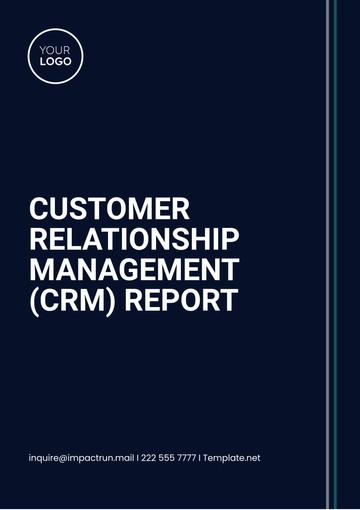Free Blank Grocery Store Customer Feedback Report

I. Introduction
A. Purpose of the Report
(This report aims to analyze customer feedback to understand their satisfaction levels and identify areas for improvement. By evaluating customer feedback, the store can make knowledgeable choices to improve the overall shopping experience, using the insights to steer strategic adjustments and prioritize actions in line with customer needs and preferences.)
B. Methodology
(Feedback was collected through various methods, including online surveys, in-store comment cards, and social media reviews, to ensure a comprehensive view of customer opinions. The report includes data from a representative sample of customers, collected over a specified period to provide an accurate snapshot of current customer sentiments.)
II. Data Summary
A. Quantitative Data
(This section summarizes key numerical data, including overall satisfaction scores and specific metrics related to different store aspects. Charts and graphs are used to display data, highlighting trends and patterns which offer a clear perspective on overall customer satisfaction and pinpoint areas where the store performs well or requires enhancement.)
B. Qualitative Data
(customer comments and suggestions, offering insights into individual experiences and perceptions. Identifying common themes aids in recognizing widespread issues and positive responses, enabling a deeper comprehension of customer sentiments and pinpointing specific concerns when combined with quantitative data analysis.)
III. Customer Satisfaction Metrics
A. Overall Satisfaction
(The average satisfaction score provides a snapshot of general customer contentment with the store’s operations and services. This metric assesses overall performance and customer loyalty, while analyzing satisfaction levels by store section—such as checkout, product quality, and cleanliness—provides a more detailed understanding of various aspects of the store.)
B. Specific Metrics
(Metrics on product quality assess customer perceptions of the freshness and variety of products available. Critical feedback helps maintain high standards in product offerings, while metrics on customer service and store cleanliness offer insights into staff performance and the store environment, which are essential factors affecting the overall shopping experience and customer satisfaction.)
IV. Detailed Feedback Analysis
A. Positive Feedback
(Highlights areas where customers have expressed satisfaction and appreciation, such as excellent service or high-quality products. This positive feedback can be used to strengthen effective practices and acknowledge staff contributions, while key comments are highlighted to illustrate particular examples of positive customer interactions, aiding in identifying successful strategies and areas for improvement.)
B. Negative Feedback
(Common complaints are identified to pinpoint recurring issues that negatively impact the customer experience. Tackling these concerns is essential for enhancing store operations and customer satisfaction, with specific problems outlined to offer actionable insights for areas needing immediate or long-term solutions.)
C. Improvement Suggestions
(Aggregates actionable suggestions from customers on how to enhance various aspects of the store. Feedback like this helps create specific improvements and better satisfy customer needs, and the proposed action plans provide practical steps to solve problems and make enhancements.)
V. Comparative Analysis
A. Historical Comparison
(Compares current feedback with historical data to identify trends and changes in customer satisfaction over time. This comparison aids in assessing the effects of previous actions and understanding changing customer demands, highlighting significant shifts in feedback trends to offer insights on whether recent changes have been successful or if further modifications are necessary.)
B. Benchmarking
(Compares the store’s feedback metrics with industry standards to assess performance relative to competitors. This benchmarking process highlights the store's strengths and weaknesses while offering a comparative analysis with competitors to understand its market position and gain insights into industry best practices.)
VI. Recommendations
A. Actionable Improvements
(Outlines specific actions to address identified issues and enhance customer satisfaction. Recommendations are ranked by their potential impact and feasibility, with short-term actions aimed at immediate improvements and long-term strategies designed for lasting benefits.)
B. Implementation Plan
(Provides a timeline for implementing recommended changes, ensuring that improvements are executed in a timely manner. This plan outlines essential milestones and deadlines, designates responsibilities to particular team members or departments, and allocates resources to guarantee successful execution.
VII. Conclusion
A. Summary of Key Findings
(Recaps the main insights from the feedback analysis, highlighting major areas of concern and satisfaction. This summary offers a concise understanding of customer feelings and significant concerns, emphasizing the necessity of addressing feedback to enhance the overall customer experience and store performance.)
B. Expected Outcomes of Recommended Actions
(Details the expected advantages of adopting the recommendations, such as potential boosts in customer satisfaction and operational efficiency, and explains how these modifications are projected to affect the store's performance and customer loyalty both in the immediate future and over time.)
C. Next Steps
(Details the immediate actions to be taken based on the report’s findings and recommendations. This section guarantees the prompt initiation of addressing feedback and offers a framework for continuous monitoring and evaluation to track progress and make necessary adjustments.)
VIII. Appendices
A. Raw Data
(The document includes copies of survey questionnaires and comment cards used for feedback collection, ensuring transparency in the data collection methods, as well as unedited customer feedback comments to support analysis and facilitate further review if needed.)
B. Supporting Documents
(It includes comprehensive data tables and charts to illustrate feedback trends and metrics visually, and also supplies any supplementary information or documents pertinent to the analysis, like historical comparison data or benchmarking results.)
IX. References
A. Sources of Data
(List all data sources utilized in the report, such as survey platforms, feedback collection tools, and other data sources, and include references to any external studies or reports that contributed to the analysis and recommendations.)
B. Relevant Studies or Reports
(Reference industry studies or reports to provide context or benchmarks for the feedback analysis, which helps to validate the findings and recommendations, and include any research that supports the suggested improvements or best practices for addressing customer feedback.)
- 100% Customizable, free editor
- Access 1 Million+ Templates, photo’s & graphics
- Download or share as a template
- Click and replace photos, graphics, text, backgrounds
- Resize, crop, AI write & more
- Access advanced editor
The Blank Grocery Store Customer Feedback Report Template from Template.net offers a streamlined solution for capturing and analyzing customer insights. Fully editable and customizable, it allows you to tailor each section to your store’s specific needs. With the integrated AI Editor Tool, you can effortlessly refine and enhance the report for optimal clarity and impact.
You may also like
- Sales Report
- Daily Report
- Project Report
- Business Report
- Weekly Report
- Incident Report
- Annual Report
- Report Layout
- Report Design
- Progress Report
- Marketing Report
- Company Report
- Monthly Report
- Audit Report
- Status Report
- School Report
- Reports Hr
- Management Report
- Project Status Report
- Handover Report
- Health And Safety Report
- Restaurant Report
- Construction Report
- Research Report
- Evaluation Report
- Investigation Report
- Employee Report
- Advertising Report
- Weekly Status Report
- Project Management Report
- Finance Report
- Service Report
- Technical Report
- Meeting Report
- Quarterly Report
- Inspection Report
- Medical Report
- Test Report
- Summary Report
- Inventory Report
- Valuation Report
- Operations Report
- Payroll Report
- Training Report
- Job Report
- Case Report
- Performance Report
- Board Report
- Internal Audit Report
- Student Report
- Monthly Management Report
- Small Business Report
- Accident Report
- Call Center Report
- Activity Report
- IT and Software Report
- Internship Report
- Visit Report
- Product Report
- Book Report
- Property Report
- Recruitment Report
- University Report
- Event Report
- SEO Report
- Conference Report
- Narrative Report
- Nursing Home Report
- Preschool Report
- Call Report
- Customer Report
- Employee Incident Report
- Accomplishment Report
- Social Media Report
- Work From Home Report
- Security Report
- Damage Report
- Quality Report
- Internal Report
- Nurse Report
- Real Estate Report
- Hotel Report
- Equipment Report
- Credit Report
- Field Report
- Non Profit Report
- Maintenance Report
- News Report
- Survey Report
- Executive Report
- Law Firm Report
- Advertising Agency Report
- Interior Design Report
- Travel Agency Report
- Stock Report
- Salon Report
- Bug Report
- Workplace Report
- Action Report
- Investor Report
- Cleaning Services Report
- Consulting Report
- Freelancer Report
- Site Visit Report
- Trip Report
- Classroom Observation Report
- Vehicle Report
- Final Report
- Software Report





























